Cairo
Day 1 - Giza, Memphis and Saqqara
Before the year 3000 BC, Egypt was divided into Upper Egypt (the southern part) and Lower Egypt (the norther part), according to the flow of the river Nile. It was finally united and with its uninion the Egyptian Dynasties were born (30 overall). The symbol of this unification is in the crown worn by most pharaohs in their statues, the red elongated one that symbolizes lower Egypt and the round white one that stands for the upper Egypt. Egyptian history is divided in Old, Middle and New Kingdom; what Cairo will let you discover is the Old Kingdom.
The capital of the Old Kingdom was Memphis, now at the edge of Cairo. The name Memphis comes from “mem” which meant “stable” and “nefer” that stands for beautiful (as in “Nefertiti” or Nefertari”). During the Middle Kingdom the capital was moved to Abu XX, in the south. The Middle Kingdom was the time when Egypt was ransacked by the Hittities who spread chaos in the country till King Amon Moses defeated them and moved the capital to Luxor, giving a start to the New Kingdom.
All these historical facts are reflected in tombs-construction and pyramids. Pyramids are characteristics of the Old Kingdom, whilst in the New Kingdom pharaohs were buried in the Valley of the Kings.
The Three Pyramids of Giza
When the Egyptian started building pyramids (with the III Dynasty), they usually built them on the west bank of the river Nile. West is were the sun sets, and were the sun god Ra will get the soul of the dead pharaoh to escort him to the after life. And of course the pyramids needed to be set on a flat area and slightly elevated to survive the (numerous) floods of the river. The Ghiza plateau served all these purpose and for this reasons the pharaohs of the IV Dynasty decided to erect their resting places here.
Despite 6 pyramids in this area, your attention will be immediately caught by the big pyramid of Cheope (2500 BC). It was build over the course of 20 years with over 2 millions block of limestone coming from a quarry on the mountains east of Cairo. It’s surface was originally smoothened by more whitish-looking limestone that was either raided in the centuries or just degraded, and it’s top adorned by a small gilded triangle (raided, it goes without saying). Do not believe the stories spread by Hollywood and by comics of slaves being forced to build pyramids. It has been estimated that 20.000 persons worked actively at its constructions, joined by 80.000 seasonal workers (those farmers that could not work during the Nile floods). And every single person was doing this work voluntary, as an offer the the living god, the pharaoh. And recompensed with beer.
The main entrance is not the one through which hordes of tourists enter today, but the one above, sealed by a a massive block of granite. This was after all a burial building, there was no need to reopen that door once the pharaoh had been mummified and buried. The entrance to the tomb is around 15$ per person, but we followed the advice of our guide and did not go inside. Aside from the massive flow of people swirling those corridors, the tomb is completely empty. There are mush better pyramids to visit inside in Sakkara. However, a stop in front of the map gave us an idea of the inside. There are three burial chambers: one is incomplete, one is falsely named the Queen burial room (the Queen has her own pyramid just behind) and the main one. However, when the tomb was opened, the archeologists found the sarcophagus with no lid and the mummy still inside; for this reason they were led to believe that there still is an hidden chamber.
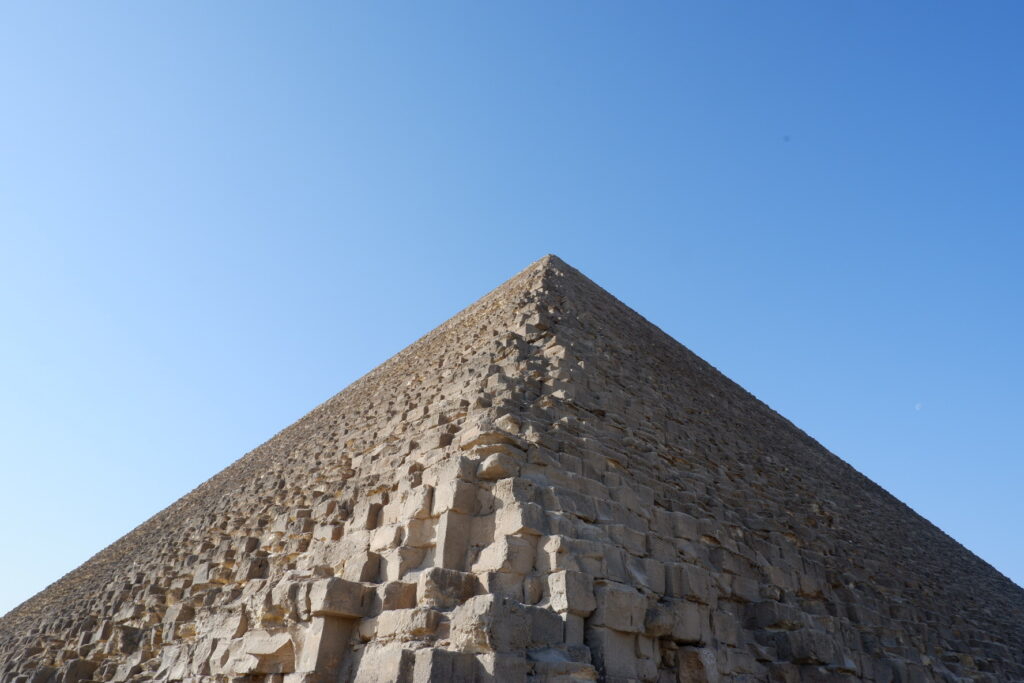
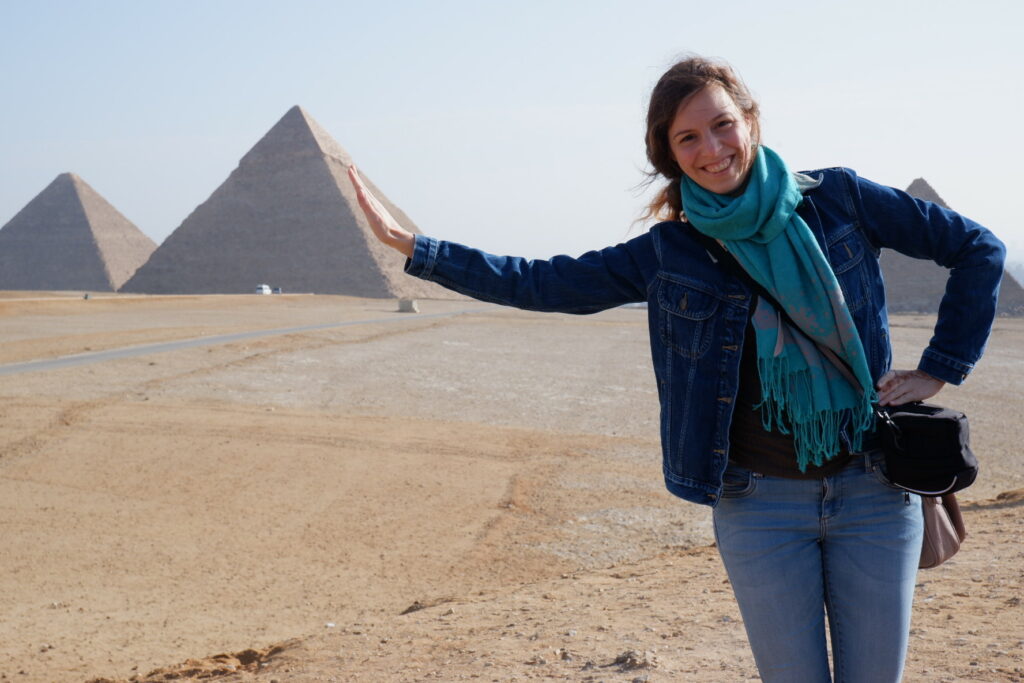
Just behind the pyramid of Cheope there are three smaller ones, for his mother, his Queen and his sister. When the archeologists were working on the pyramid of the mother, they accidentally found an hidden pit (preserved by the sand from the tomb raiders) with the furnitures of her royal chambers.
In 1950 on the North side of the pyramid, another pit was discovered hiding the wooden remains of a boat; this boat, that symbolizes the sun boat through which the soul and body of the pharaoh would cross the river to the afterlife, has been recently restored and can be visible in the Museum.
On the east side there can be found the mutabahs. Only pharaohs could be buried in a pyramid, but the nobles and the ministers could build smaller and flat tombs around the pyramid of the pharaoh they served. Those cannot be accessed but later during the day there is a treat waiting for you!
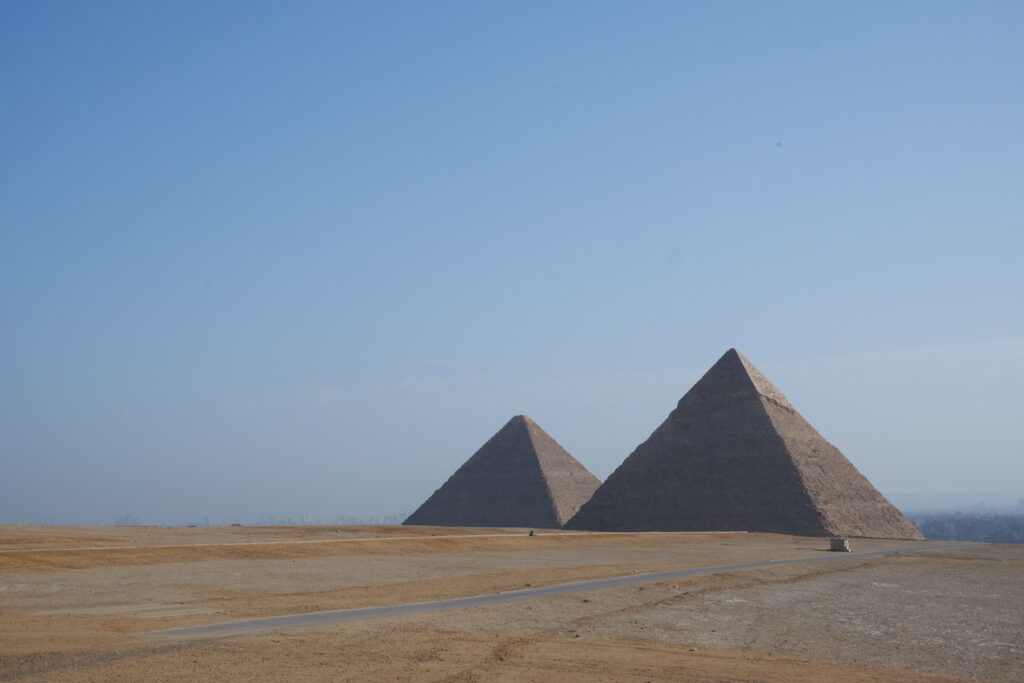
Cheope’s second son, Chefren, built 50 years later a smaller (but still impressive) pyramid right behind the big one of his fater. The best view is following the paved street till the viewpoint with the parking lot: from here the 130 m of the pyramid of Chefen will appear to you much more than the ones of Cheope, but it’s simply because it’s built on a higher plane. Look at the tip of the pyramids and you will understand how they were looking in the ancient times, with that whitish limestone cover that made their surface smooth. It’s the only tomb in the Ghiza plateau that has a funerary temple (more to come about it!). Just to the left, the grandson of Cheope, Micerino, built his pyramid 70 years later
The Sphynx
Even before reaching the Sphynx, you will notice the harbor at its feet. Before the construction of dams the Nile flooded once a year and its water used to cover the 7 kms to Giza and were used to carry the blocks of limestone from the quarry to this area.
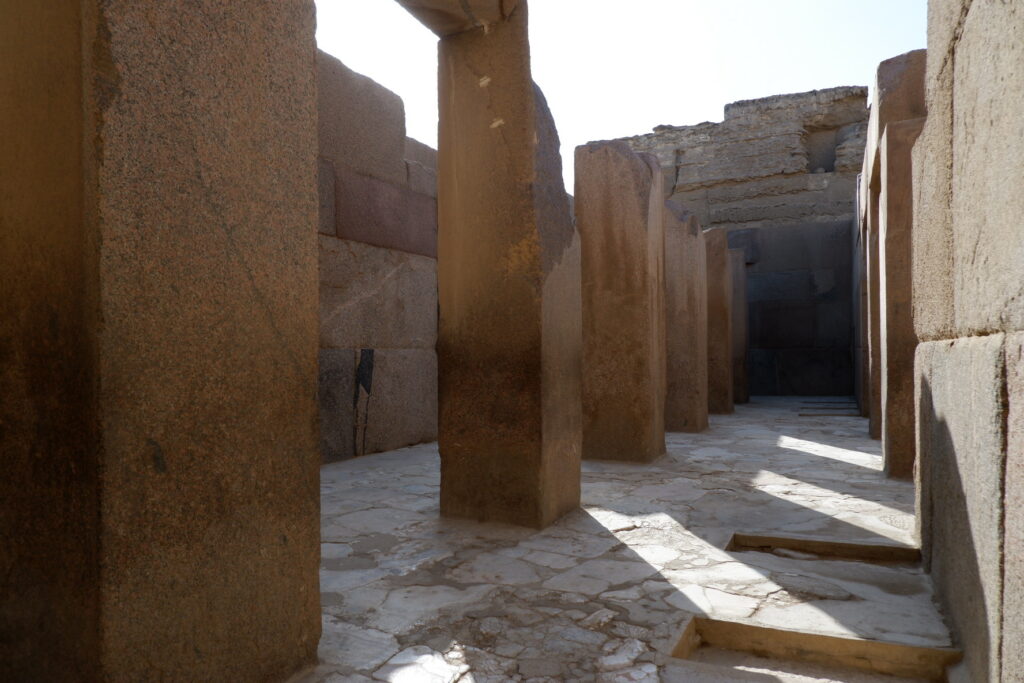
Just to the right of the harbor, the entrance to the valley of the funerary temple of Chefren opens for you: this funerary construction is made of external limestone, but the walls are made of granite and the floor is alabaster. There used to be a granite roof as well but his son Micerino recycled the material to build his own pyramid…
This area were you are standing was were the whole process of mummification was taking place. The body of the deceased pharaoh was brought here and the priests washed him with Nile water. His face was then dressed with the jackal mask of Anubis, the deity of the afterlife, the inner organs were removed and put in small jars (canopi) but not the heart, that was embalmed and resealed in the chest cavity. The body was the immersed in salt water to let the skin dry, washed with essential oils and covered with linen bandages. The bandages were glued together and the mummy was carried along the ramp that you see in front of you up to the pyramid.
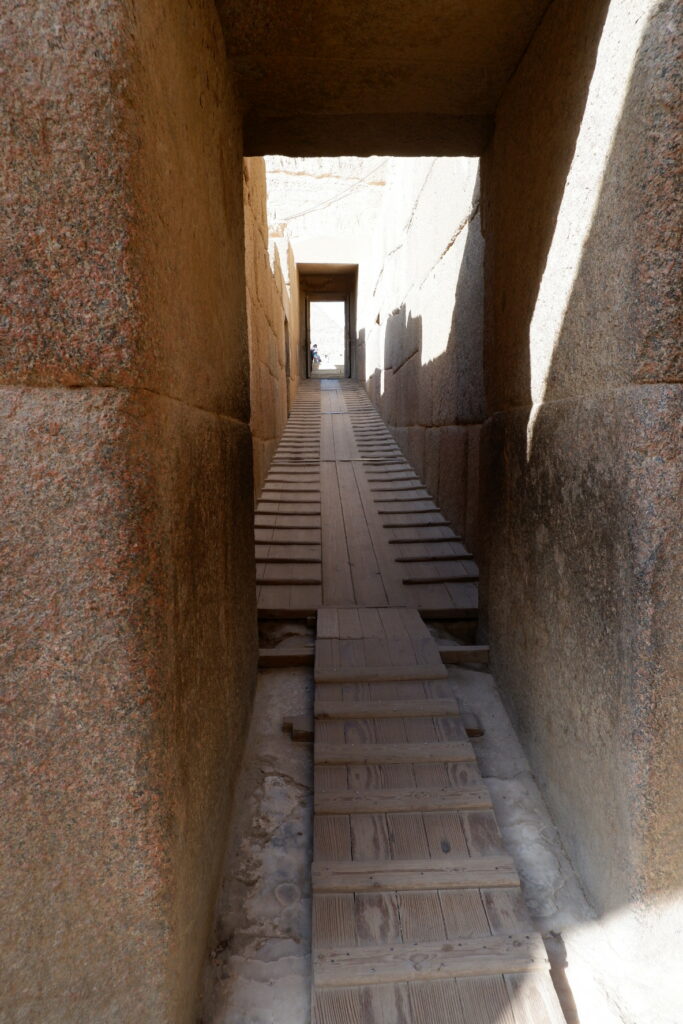
Now follow that same ramp that the dead pharaohs were taking and reach the marvelous sphynx. The name sphynx comes from the ancient sheseban (image of a god). Its origin dates at the time of the construction of the pyramid of Chefren: that area was being used as a quarry for the limestone and one massive piece was left untouched because of its poor quality. The workers carved it with the body of a lion and the face of Chefren. For years it lay covered by layers of sand; in 1750 BC an Egyptian prince that was visiting the pyramids fell asleep on the sand and in his dreams the Sphynx spoke to him asking him to unbury her and become a true king. Upon waking up, the prince started digging and brough the Sphynx back to light, thus becoming pharaoh Thutmose IV. During the centuries the sphynx was worshipped by the Greeks and the Romans conquerors who built small temples in front of her. The nose is missing due to an Arab fanatic in the Middle Ages that believed the Sphynx was a malevolent spirit.
On your left while you are standing on the ramp, look for the village where the pyramid builders used to live.
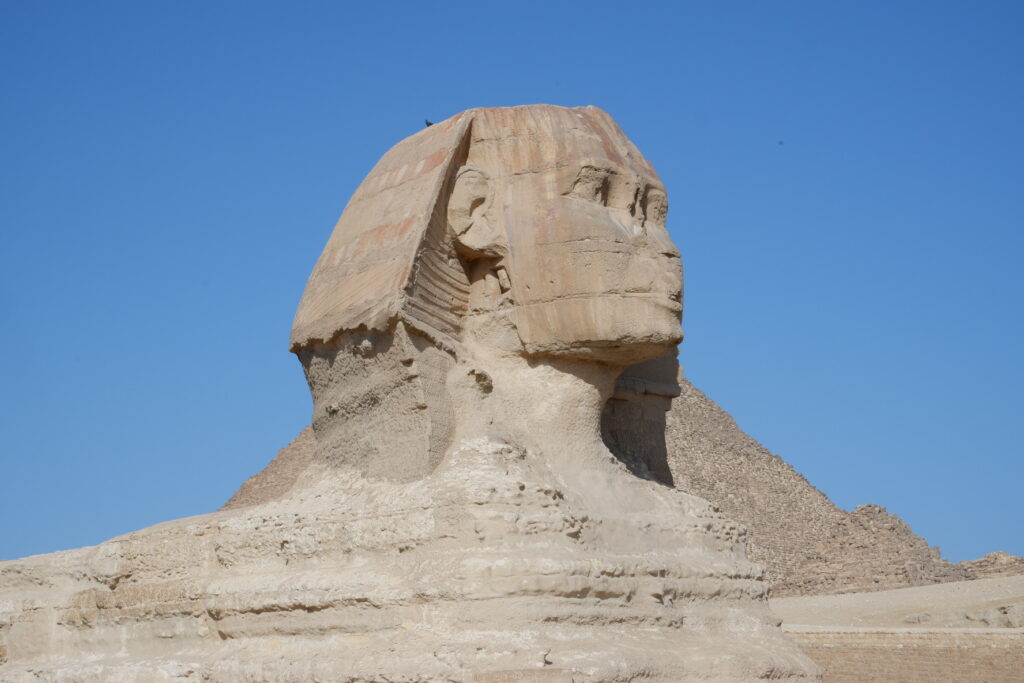
Memphis
Even during the New Kingdom, when Luxor was capital, the famous Ramses II resided in Memphis during the year. Here he built his palace, whose ruins now cover the whole neighborhood, and a temple dedicate to the god Ptah, deity of creation. The ruins of the temple are nowadays an open air museum in the middle of Memphis. Statues of the god are everywhere, either depicted as he is molding clay or holding a sceptre. You will notice that differently from Giza, where the ruins have been well preserved by the dry soil, here almost all the statues are ruined because of the clay’s presence. Only two are still in one piece, the sphynx (depicting either a pharaoh, or his XXX) and the granite statue of Ramses II. Ramses is depicted with symbols of Upper and Lower Egypt, and his left leg forward, since he his actions are commanded by his heart. Inside the museum there is a bigger limestone statue of Ramses II, found lying there on the left side; for fear that the materials would get damaged, the whole museum was built around it. Ramses II or Ramses the great ruled from the age of 26 for 67 years, and he had 40 wives and over 200 children. All the statues of the pharaohs are depicting some hieroglyphs that carry their birth name and the coronation name inside an oval (cartouche). As every hieroglyph, they can be read either from right to left or from left to right, depending on where the faces of the humans or the beaks of the birds are oriented. But of course such a difficult and elaborate way of writing could not be used in everyday life, and the more simple demoticon was used for contracts, marriage licenses etc.
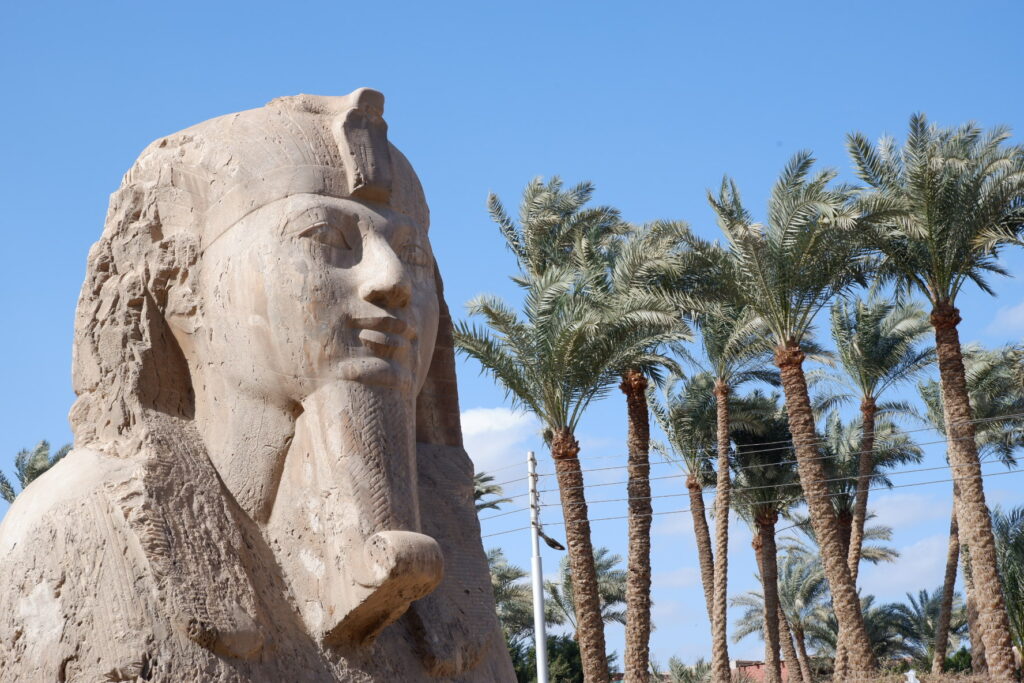
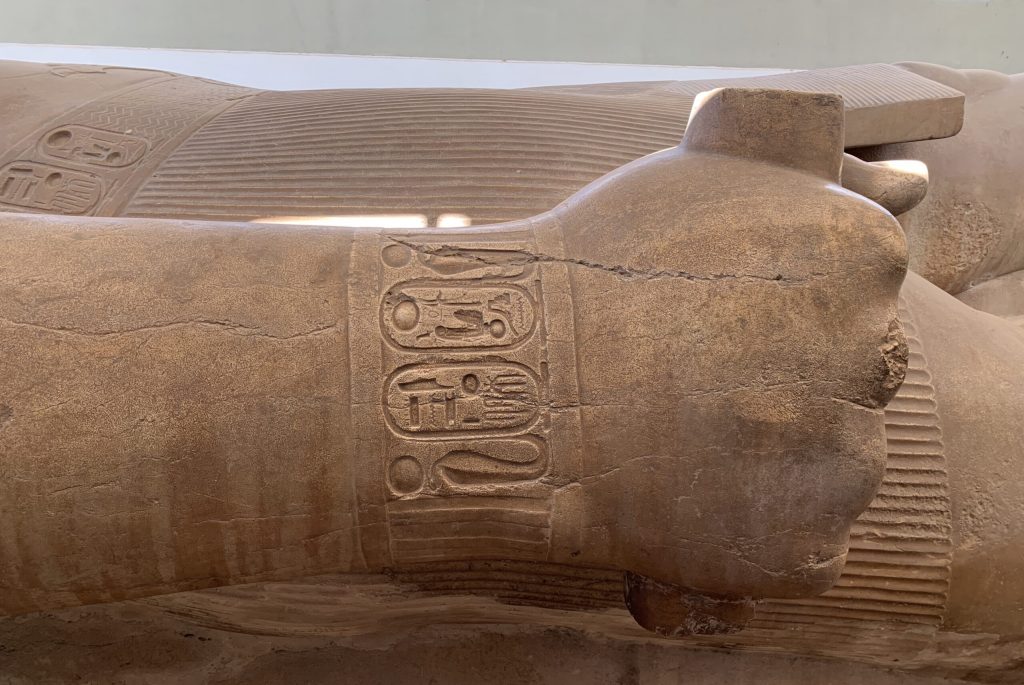
Saqqara
When driving around Memphis it’s stunning to see the plush vegetation of palms and other trees, but it’s even more impressive the abrupt stat of the desert once you reach Saqqara. Seems like the exact place where the water of the Nile reached at the time of its floods is marked by a line of trees that suddenly turn into sand. Saqqara gets its name from the god with the face of a dog that was hereby worshipped. In Saqqara you will see the first pyramid, called the “step pyramid” (2700 BC).
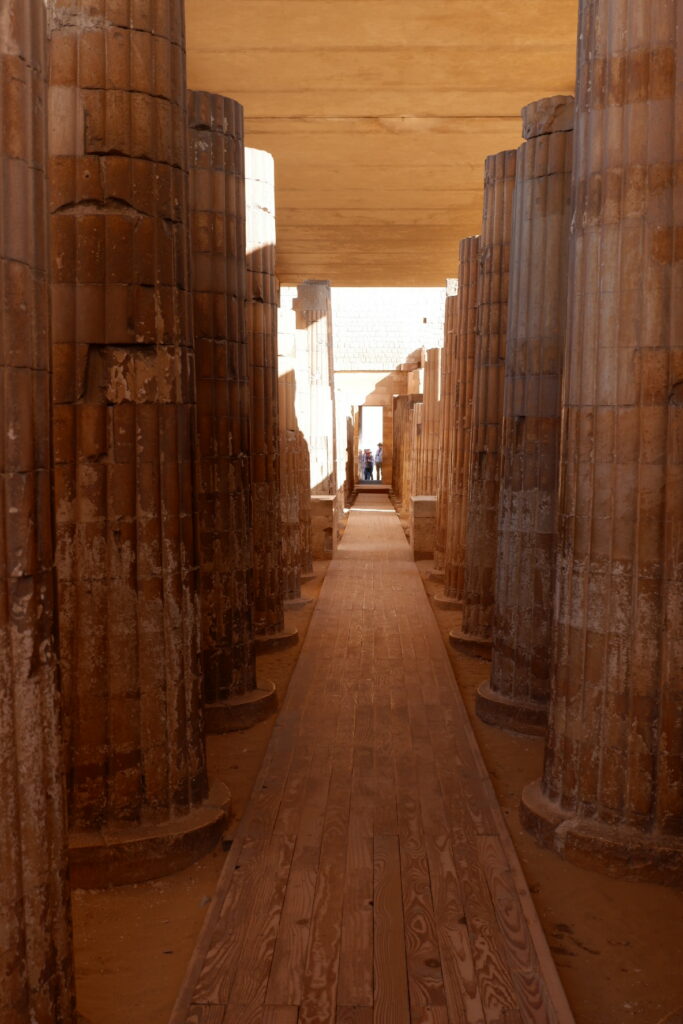
The First and Second Dynasties of pharaohs were buried in mud mastabaha that of course did not survive the injuries of time. The first pharaoh of the Third Dynasty, Djozer, was the first one to commission to his architect Imhotep a stone tomb that would survive for centuries. Now, we all know the name Imhotep from movies such as The Mummy; the truth is that after this first building he became so famous that he was nearly revered as a god. First of all, Imhotep built a colonnade entrance with 42 columns shaped like papyrus plants, that symbolizes the 42 provinces of Egypt (there is also a small wall separating the Upper from the Lower Egypt. He was still not confident enough to believe that the columns would held the weight of a granite roof of papyruses trunks so he attached them to the wall.
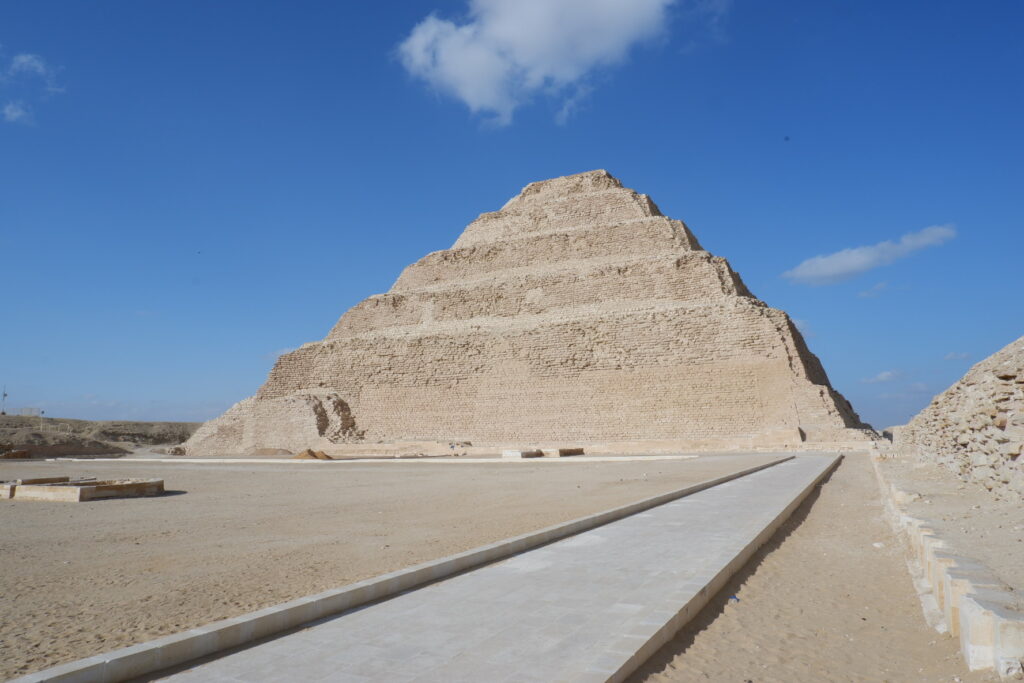
You walk the colonnade and reach an open court, symbolically delimited on your left by a mastabah and on your right by the step pyramid. The first idea of Imothep was to simply build a stone rectangular mastabah; upon seeing it Jozer asked him to make it longer, the to add a send mastabaha on top, then one more, and so on. This is why the pyramid has this appearance of steps. Djozer’s son got the idea from his father but his pyramid crumbled to pieces. It was Djozer’s nephew Neferu that carried on the pyramid idea, first building a very audacious 56 degrees steep angle pyramid that he had to adjust towards the tip (bent pyramid of Dashur) and the building the first real pyramid ad we know them in red limestone (red pyramid in Dashur).
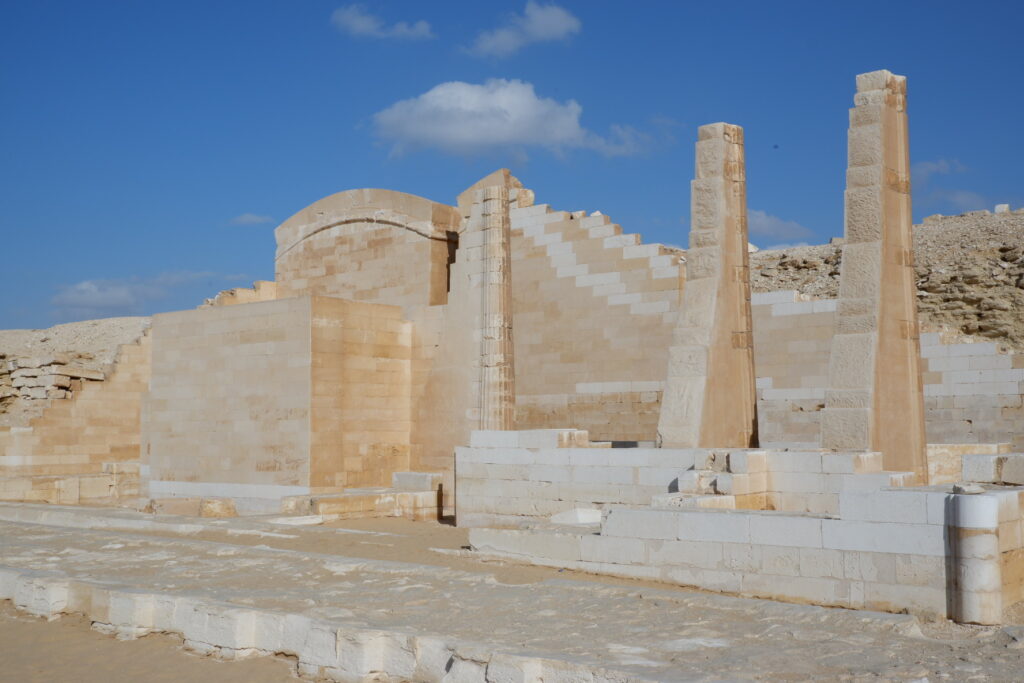
While walking the open court look for an opening to your right: this is the area where the hepstat festival was held. The hepstat was sort of a reconfirmation of the pharaoh every 30 years, where he was to battle with a bull to prove he still ha the strength to rule. Later on in the dynasties, this became a rule every 5 years cause rarely the pharaohs ruled up to those 30 years.
After the brief excursus to Memphis for the Fourth Dynasty, the Fifth Dynasty went back to Saqqara for their pyramid building. Don’t be discouraged by their appearance from their outside: yes, they do look just like mounds of sands, but that simply because the blocks of limestones had been “recycled” by the 4 following Dynasties of the Middle Kingdom when the economy was not doing well. The Fifth Dynasty pyramids were the first to have hieroglyphical carvings inside. Those were either prayers or spells that the dead pharaoh could use to pass through various chambers or alcoves of the afterlife. This habit was lost in the Middle Kingdom, and was resumed in the New Kingdom where the walls of the tombs were carved with hieroglyphics and papyri guiding the pharaoh through the afterlife journey. What came to be known as “The Book of the Dead”.
In Saqqara you will encounter the pyramid of Teti, the one pyramid which we visited inside. Through a small and long tunnel you will reach two burial chambers, where the roof is covered with carving of stars and the walls of hieroglyphs; look for the cartouche of Teti XXX. In the main chamber you will be awed by the size of the sarcophagus around which the whole pyramid was built, cause there would be no way of making it fit through the small corridors.
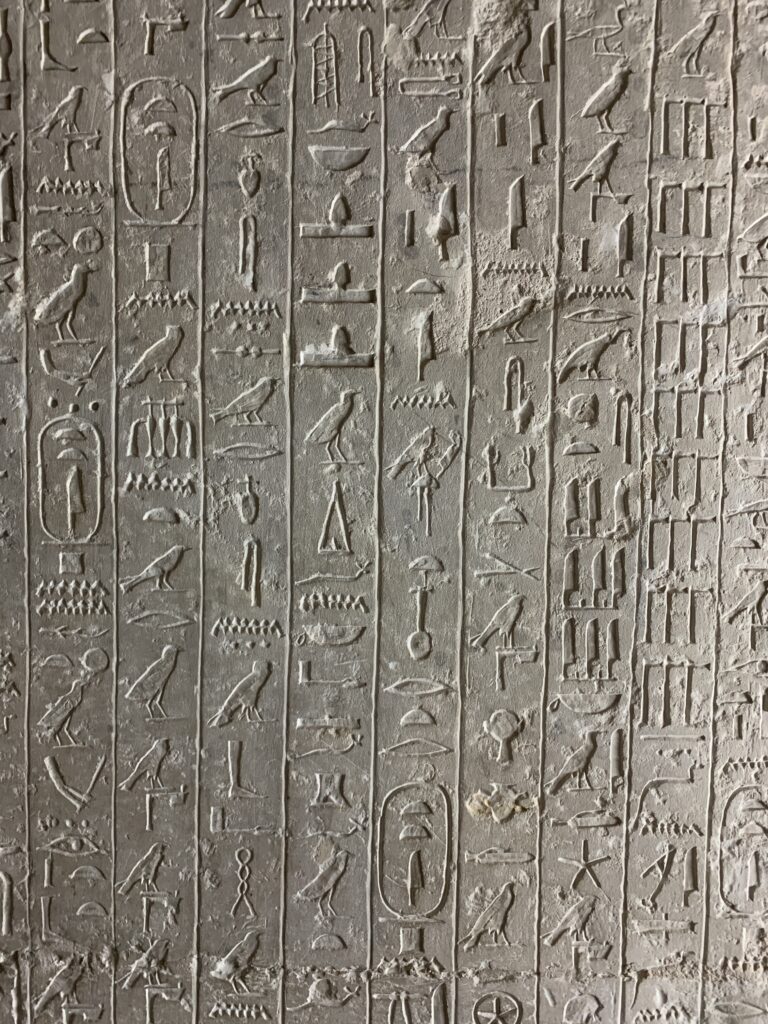
Just out of the pyramid, the real jewel is the mastabah of Teti’s prime minister and brother-in-law. The inferior part of the wall was covered thought the years by sand and it’s just perfectly preserved. As you walk through the chambers, various altrelief depict scenes of everyday life, hunting scenes, and some colors are also preserved.
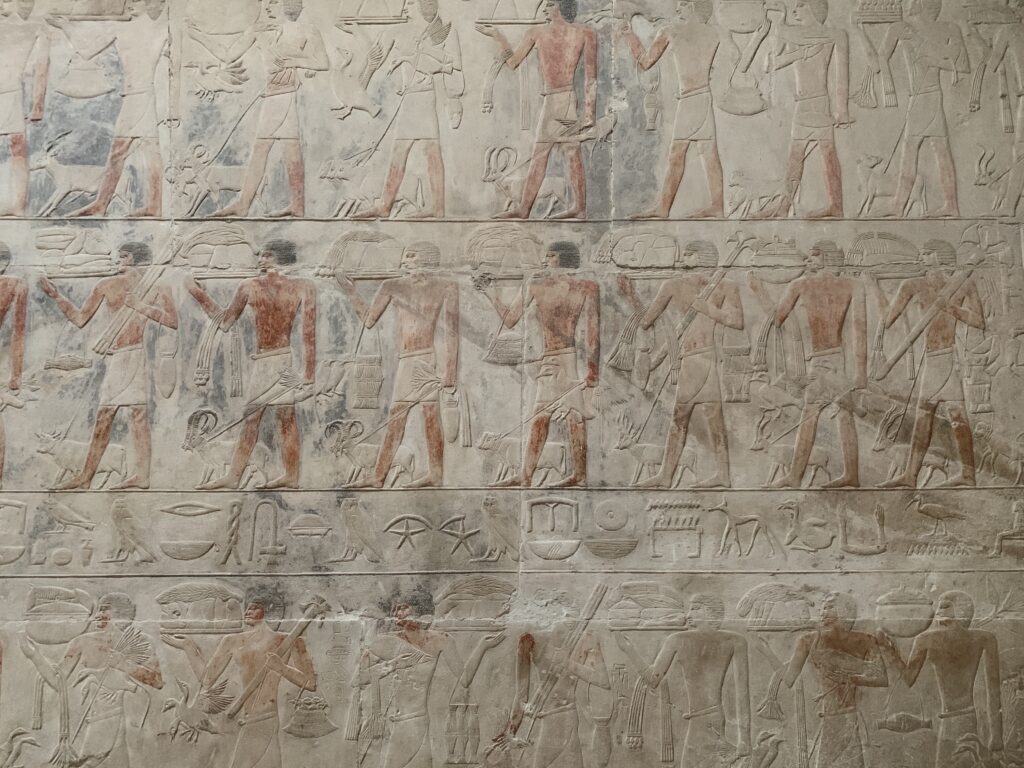
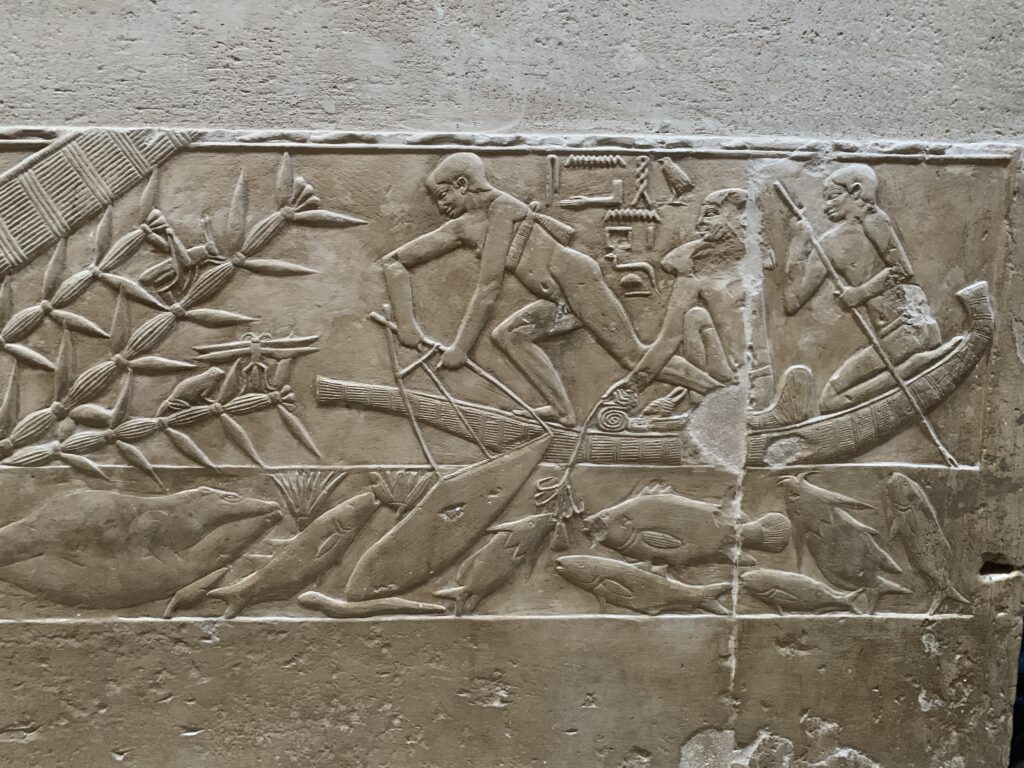
Day 2 - The Egyptian Museum
The Egyptian Museum was first meant to rise on the West Bank of the Nile, but the French who were leading the project soon realized it was too dump and they started to build it in 1897 on the East Bank instead. The facade is strongly pink, with statues of Isis wearing greek tunics and the latin names of the Egyptian dynasties. Lotus and papyrus plants (symbols of Lower and Upper Egypt) decorate the garden.
The lower floor is mainly dedicated to the three Kingdoms and the upper floor to the Tutankhamun collection. The first feeling when you walk inside is that someone is moving out, boxes on the sides of the rooms, walls half painted, tape and scaffolds, and plastic sheets over some of the antiquities. Fortunately the new museum (over which 1 billion dollars was spent, with donations from all over the world -300 millions from Japan-) seems to be almost ready to open and host the entire collection by the end of 2020.
In front of the entrance on the right hand side there is a copy of the Rosetta stone (the original is at the British Museum). It dates to the era of Ptholomeus V and reports the same thing in hieroglyphic, demotic and ancient greek. Thanks to this a French linguistic by the name of Champollion was able to interpret hieroglyphics for the first time.
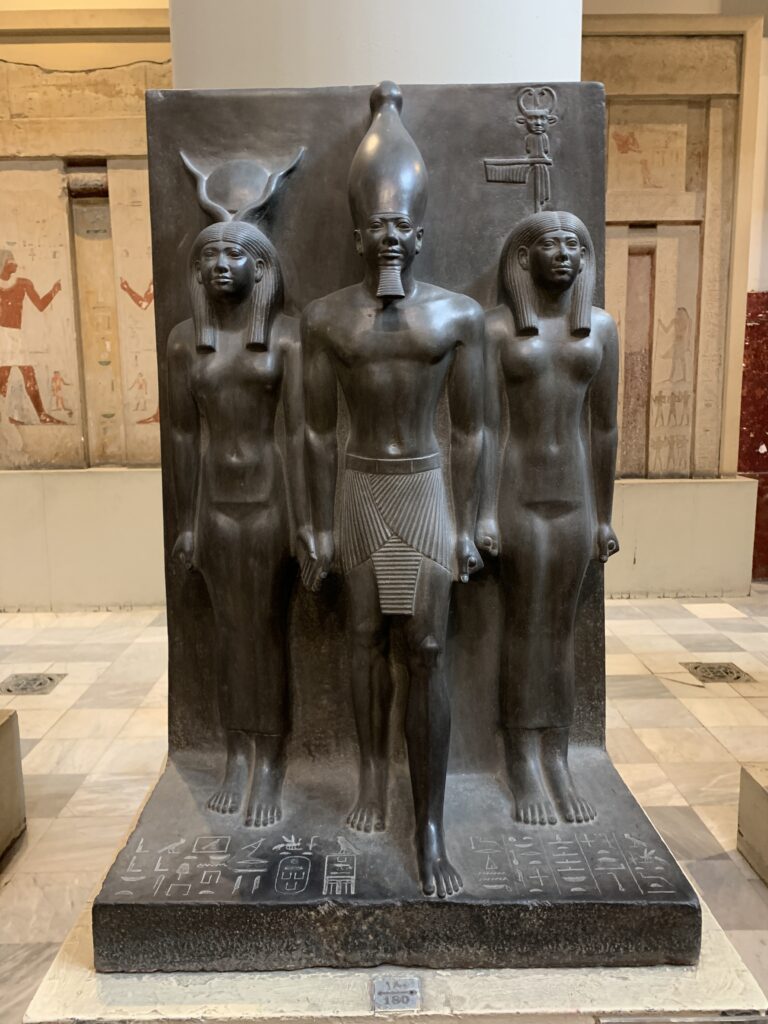
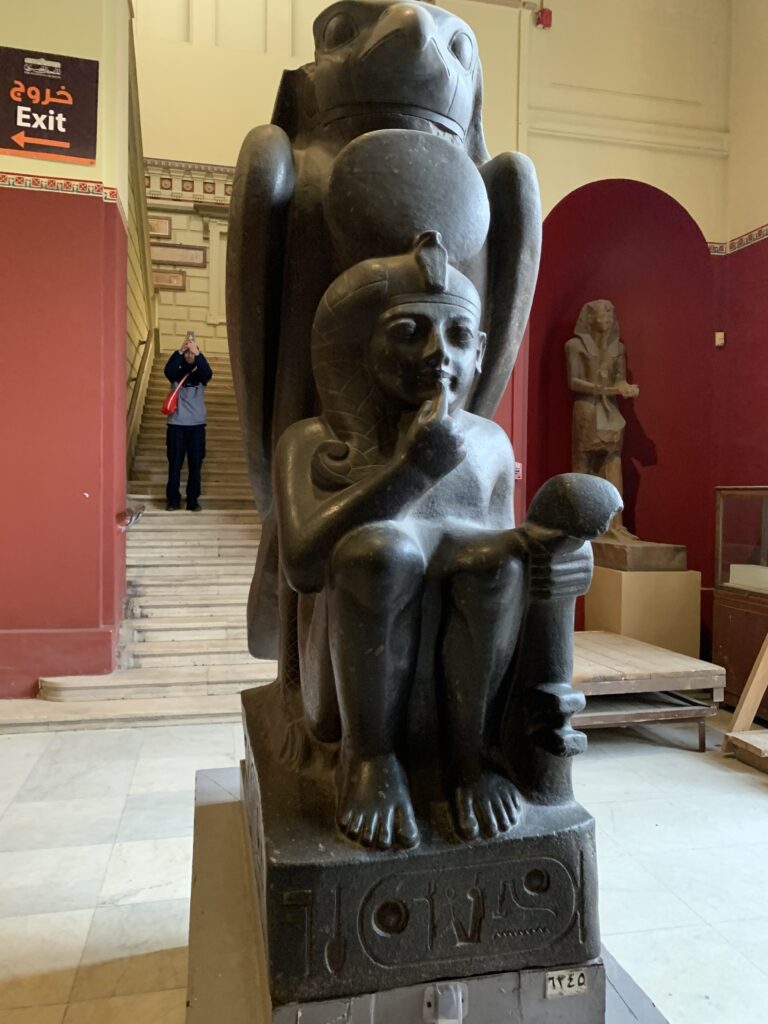
On the left corridor you will encounter artifacts of the pharaohs who commissioned the pyramids from our Day 1 visit: Djozer (the most ancient statue of the museum dating 2700 BC, his right hand closed on the chest to symbolize power and the left resting on the leg in a sign of peace) and Mykerinos (depicted in 3 steles with the horned goddess Hakkur and a second female figure representing one of the 42 provinces of Egypt, which started the belief that there were a total of 42). In the cases take a look at the small heads that were buried in the sarcophagus in case the mummy was destroyed, to allow the soul to find the right body at the time of resurrection. On the walls dozens of false doors catch your attention, those were found in the tombs and only the soul was able to pass through them.
At the end of the corridor turn right and then right again. This room hosts a few masterpieces. In the centre of the room, the durite bust of Chepren, with a falcon protecting his neck from behind. On the left one of the very few wooden statues (made of sycamore wood) representing a high priest. The eyes are the particularity: the white is made of quartz, and the eye is crystal with a nail in the centre to mimic the pupil. The same eyes are found in the limestone statue of a scribe in an adjacent case. Here the eyes outline is made of copper, that due to oxidation has acquired a green hue, making it look like make up.
Remember the smaller pyramid in Giza, behind Cheope’s, belonging to his mother? The alabaster sarcophagus, the canopis, the furnitures (bed, chairs, walking throne) that were found in the shaft next to her pyramid are all displayed in the next room. Here a case displays a tiny ivory statue, the only remaining image of Cheope. Cheope’s brother and his wife are depicted in two statues with amazing colors: note how the skin coloration of the men is always darker compared to the females’ (who were rarely under the sun). Cheope’s brother was the general of the army, so both his fists are clenched.
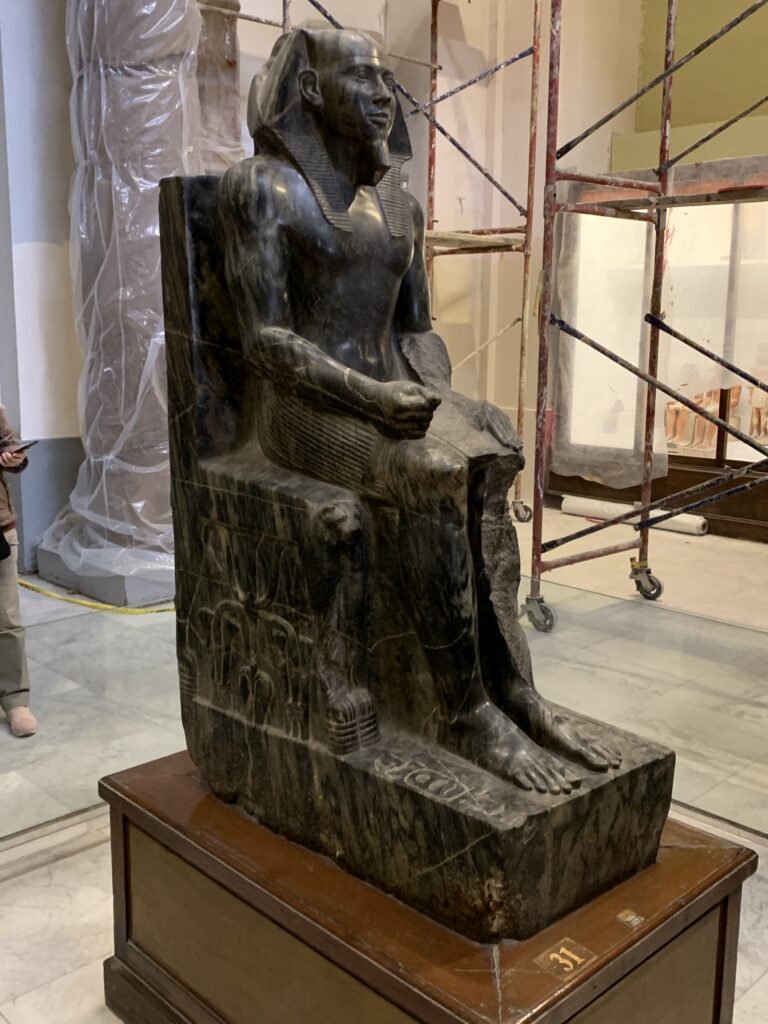
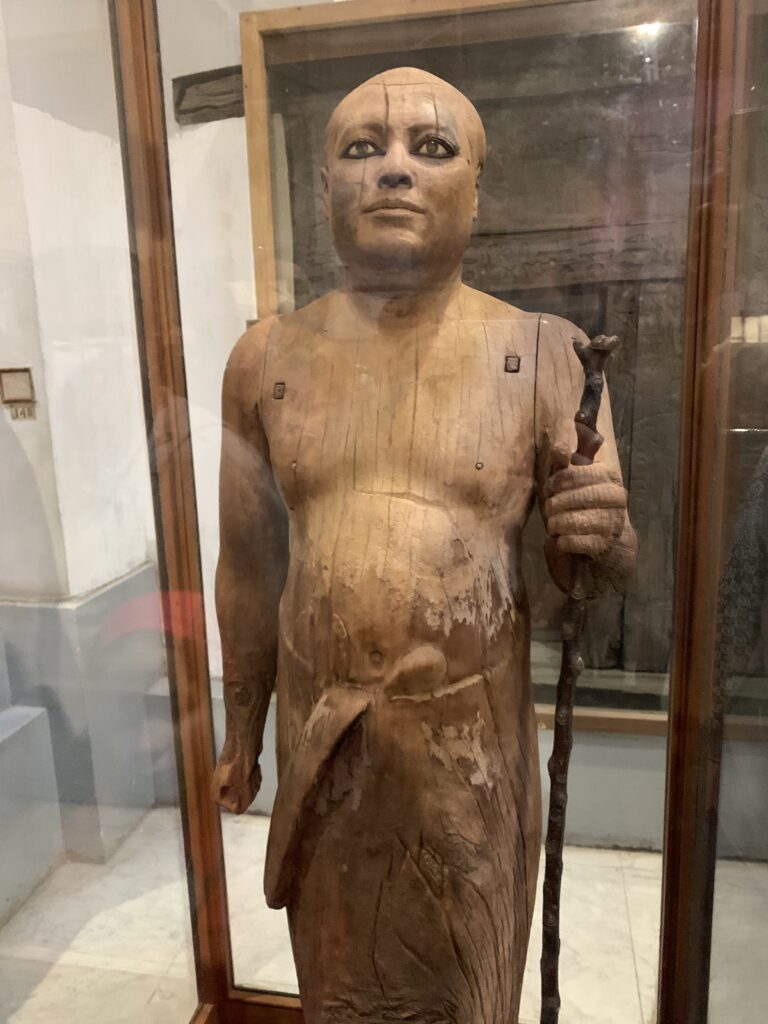
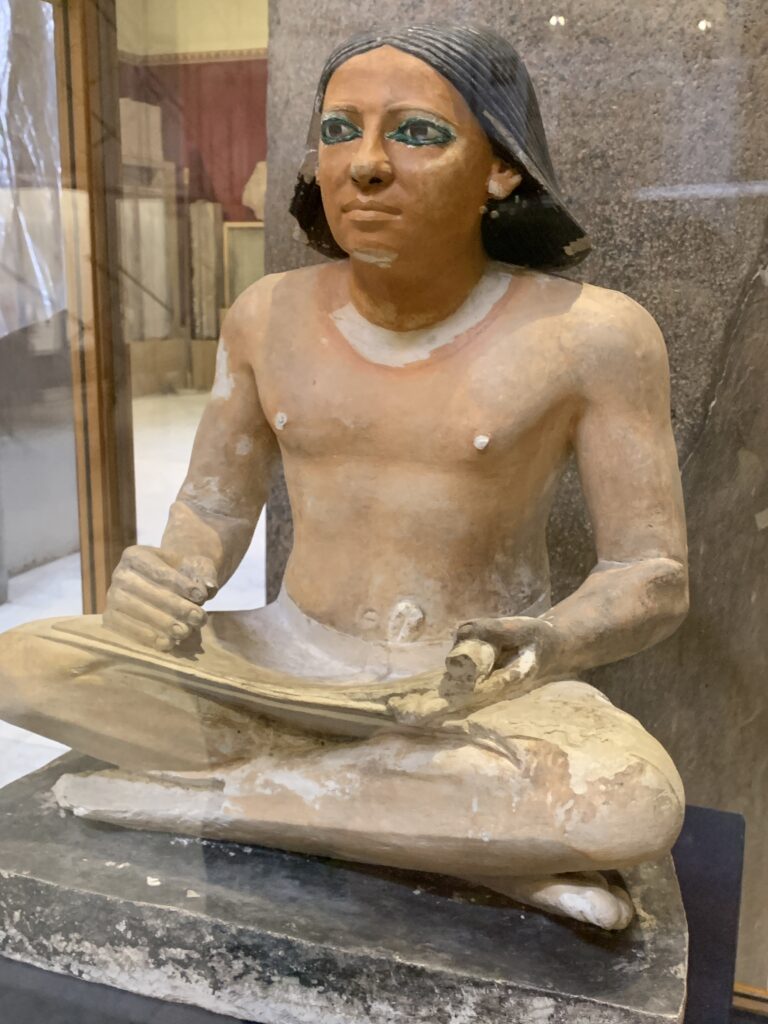
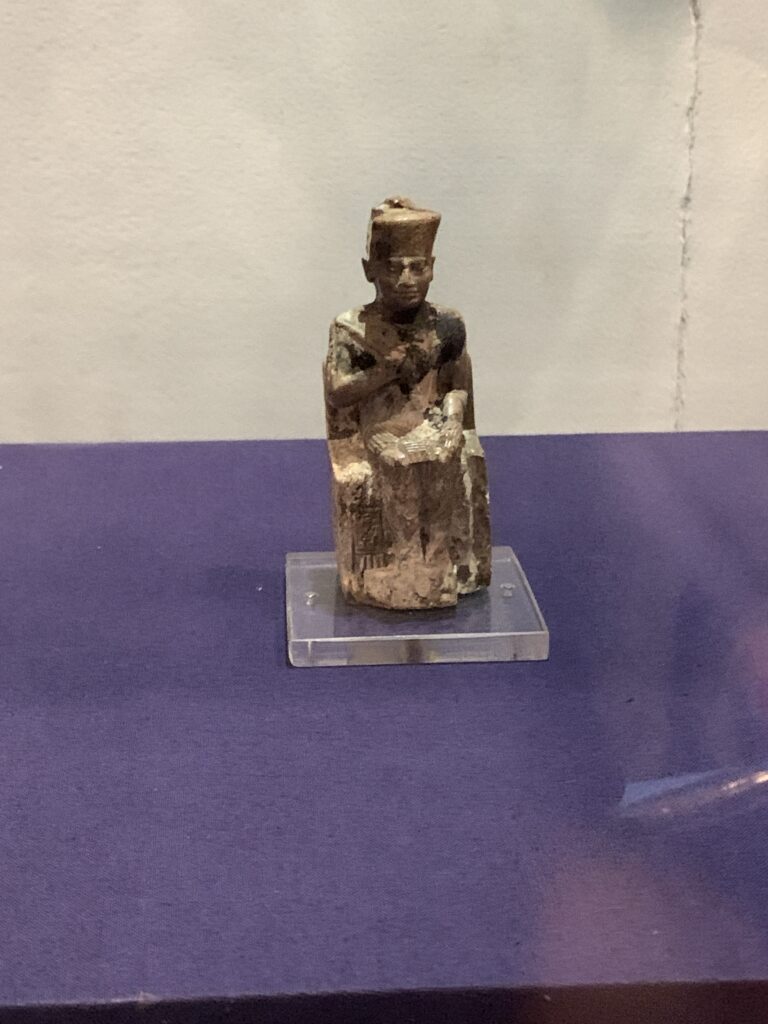
Out of this room begins the Middle Kingdom. Here the sarcophaguses are inlaid with sacred hieroglyphics inside since pyramids were no longer being built. The Middle Kingdom only lasted 2 Dynasties before the Hittites occupied the country for 200 years. This long period of occupation is reflected in the sphynx that you see along the corridor with the face of a lion, far from the Egyptian style. But look closer and you will see between her paws a cartouche: once the Egyptians took their reign back, they carved all the Hittites statues.
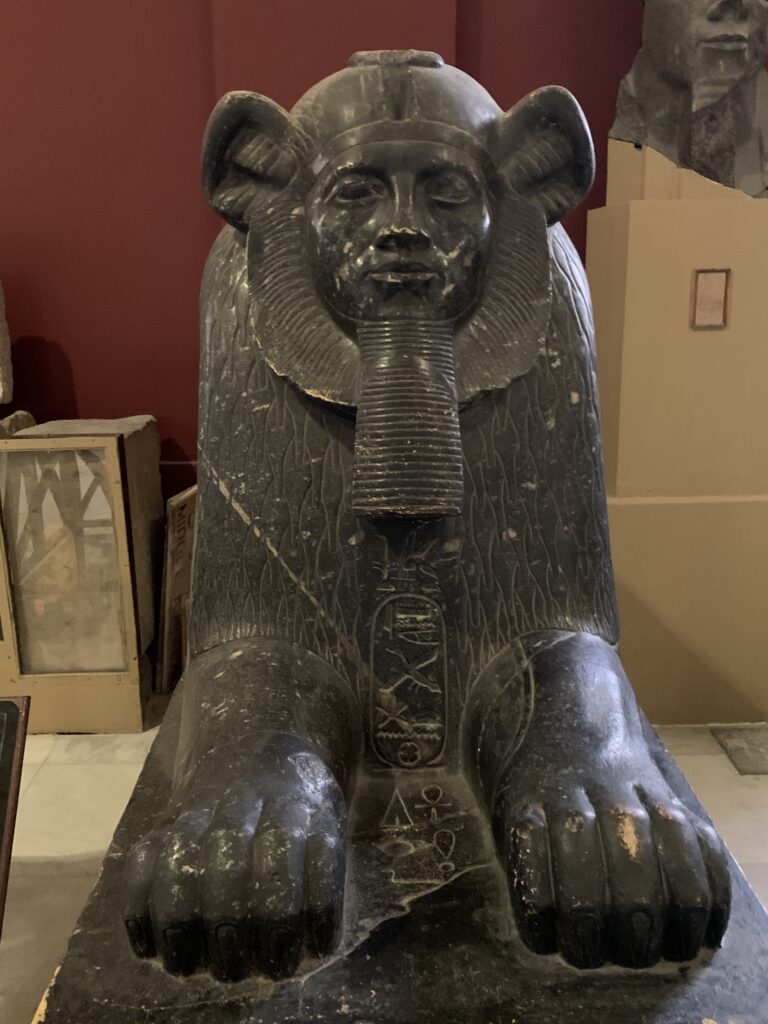
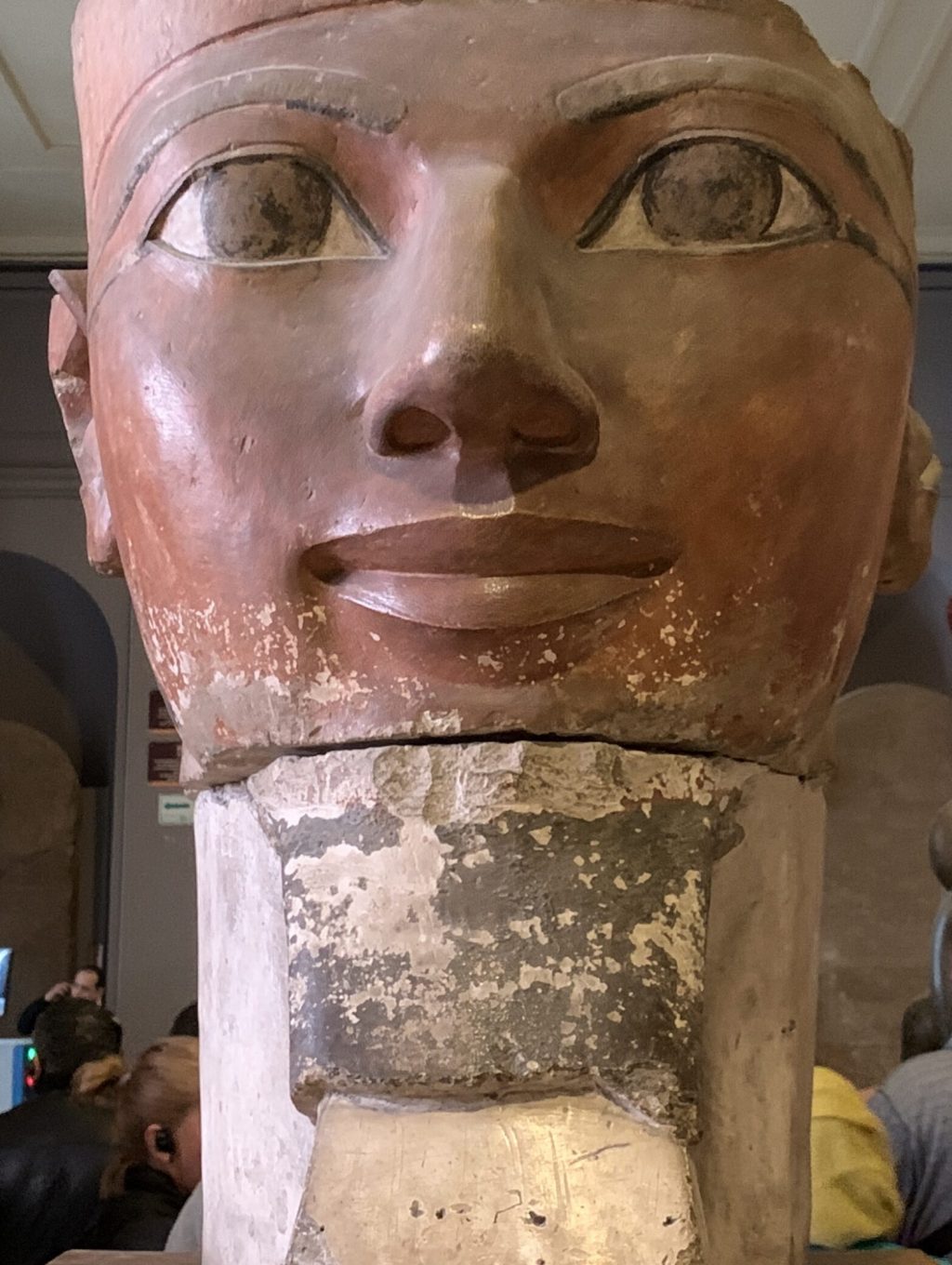
Once the Hittites were chased, the New Kingdom started, the pharaohs were now identified as gods. Art changed, with carved faces on sarcophaguses, statues with longer and curved false beards, as you can see in Hatshepsut’s bust. But, wait! Hatshepsut is a woman, how can a woman be pharaoh? Hatshepsut was the royal daughter of King Tuthmosis I. She married her half brother and together they had Tuthmosis III, future heir of the throne. After her husband died, since her son was too young to rule, she proclaimed herself pharaoh and kept the power even when Tuthmosis III reached the adult age. According to testimonies she had a strong personality and was a great ruler, exploring Africa and being depicted with the darker skin of a man. Around the bust you will see some statues of her and a sphynx with her appearance, none of those carry her cartouche since her son after her death removed all of them as a sign of contempt for the mother who stole his throne.
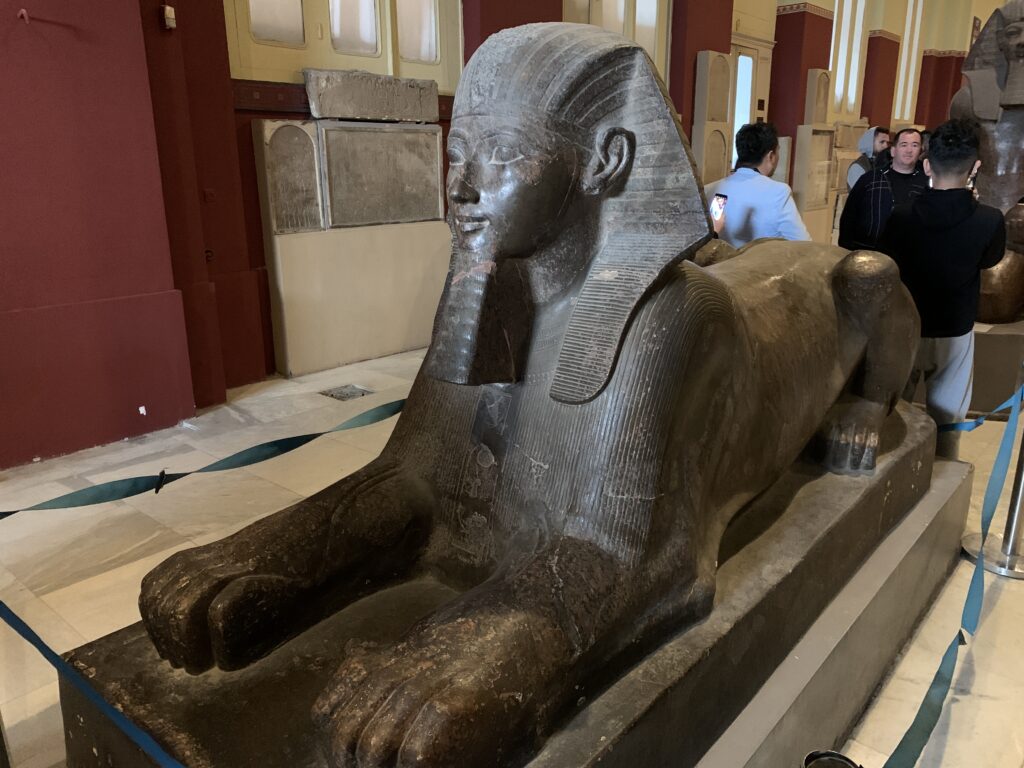
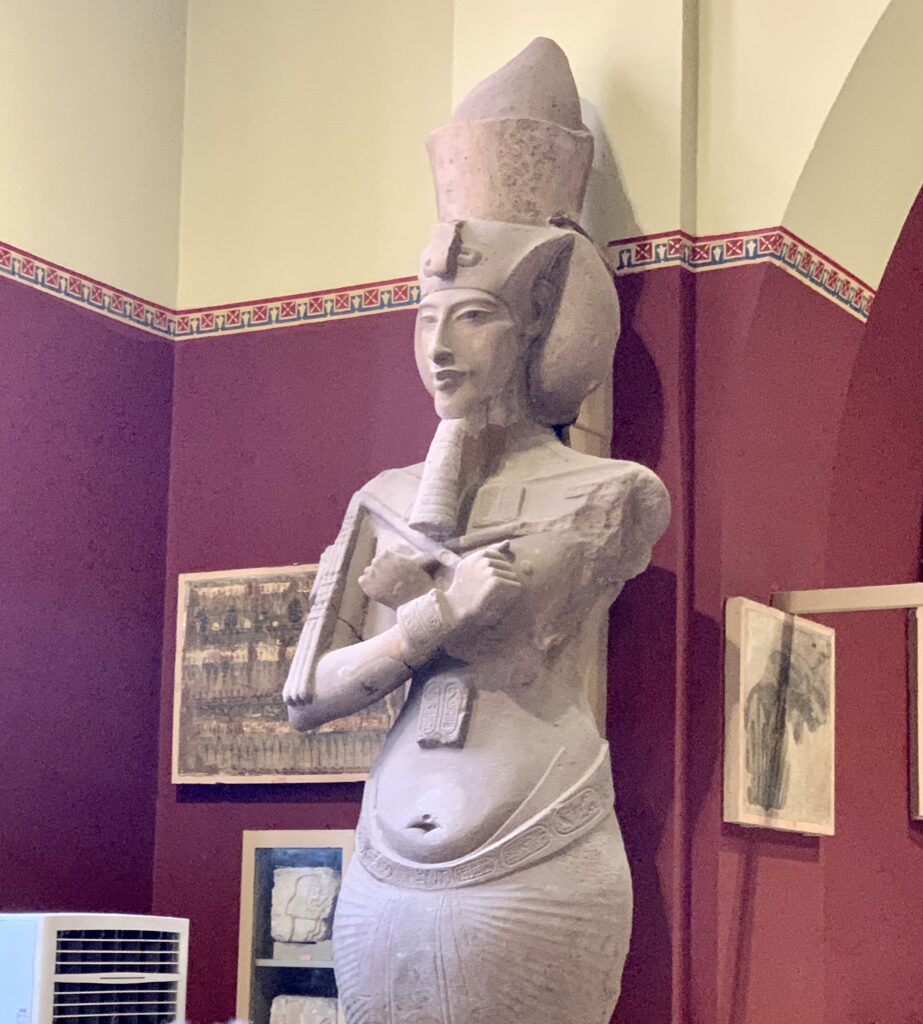
Continue along the corridor and on your left a room is dedicated to Amenophis. With the New Kingdom, Luxor became the capital and its protecting local god, Amon, started being identified with the sun thus becoming Amon Ra. During the Eighteen Dynasty, King Amenophis III started professing the existence of a single god, Atten god of the solar disc. He forbade the worshipping of any other god, closed all temples and made himself intermediary between the people and the god, taking the name of Akhenaten. This was the first ever attempt to a monotheistic religion. Two important facts can shed more light to this religious change. The arrival of Joseph into Egypt according to the Bible dates around this period. Secondly, the parents-in-law of Amenophis III (whose wife was Nefertiti) carried very non-Egyptian names, Yuya and Tuyah, with a strong jew influence. In any case who was very unhappy with this monotheistic religion were the priest who fomented the crowds and overthrew the pharaoh, making his young son Tutankhamun king. In the room dedicated to Amenophis III the cartouche is missing from all the statues, removed by the priest to condemn him from eternity (the soul was not able to find its body without it). Amenophis III revolutionized art, his statues are androgynous since the pharaoh as an intermediary to the god was bot male and female. He was one of the few pharaohs that allowed representations of scenes of everyday royal life with his wife, Nefertiti (whose beautiful face you will see in a casa on the left), and his son Tutankhamun.
Now climb the stairs to the upper floor, admiring the long papyri with the book of the dead that accompany your ascent.
The upper exhibition starts with the story of how Tutankhamum tomb was found. Tutankhamum was 9 when his reign started and 19 when he died. Compared to other pharaohs he definitely played a minor role in the history of ancient Egypt, but he came to be very famous in the modern world since his tomb was the only found intact (up to now).
Carter, an english archeologist had been digging in the area for years and never found anything. The tomb of Tutankhamun was just next to the one of the one of Ranses IX and no one thought there could be another one in the vicinity. For this reason the tents of the workers and the other archeologists were laid on top of the site where the tomb was buried by layers of sand. It was discovered on the 4th of November 1922 by chance, a local child was playing in the area and tripped on a hidden step. The step lead to a corridor at the end of which a door was hiding around 5000 antiquities in perfect state.
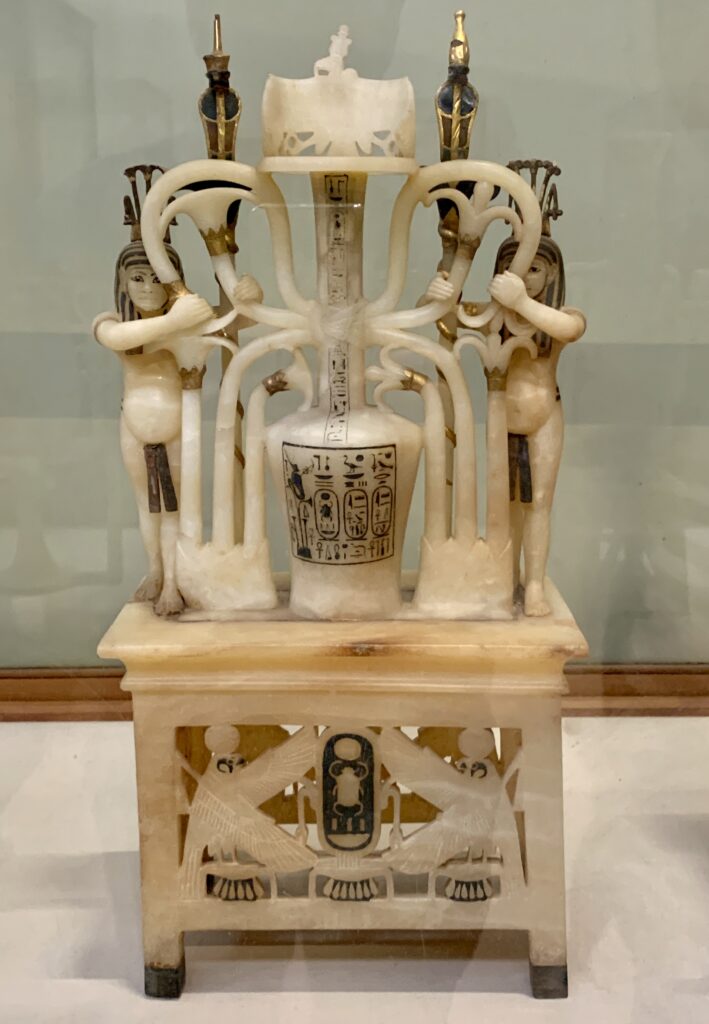
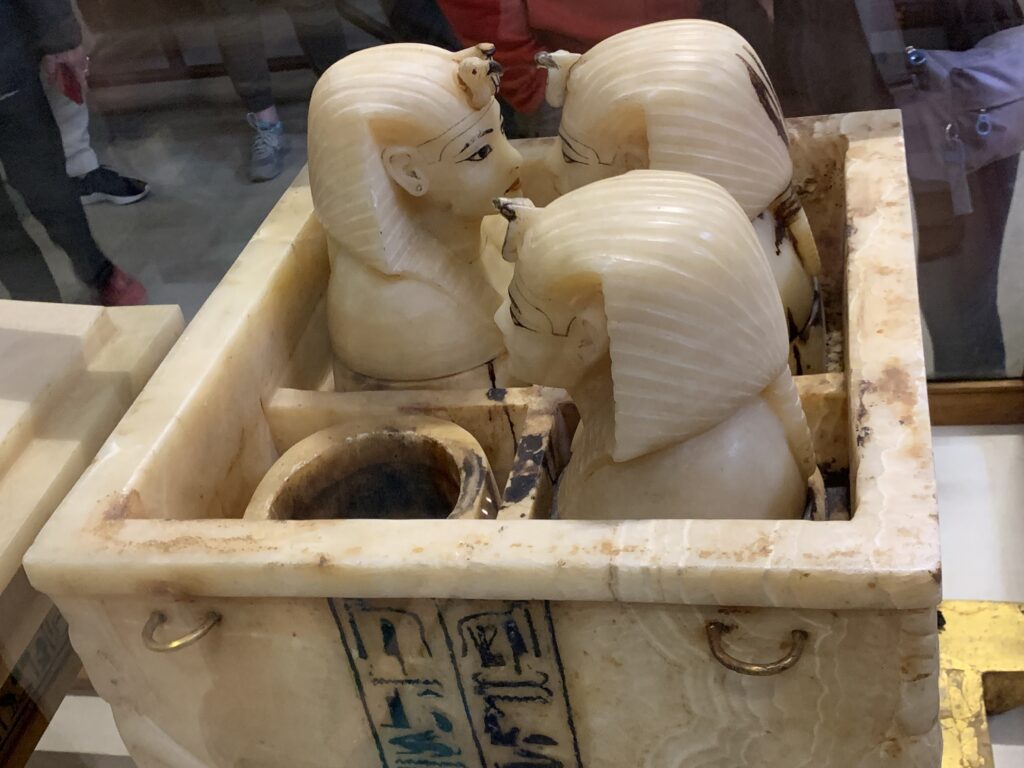
Amongst the treasures there were thrones, canopis, jars with essential oils, foldable beds, festival chair and a lot more. Interesting is to notice that two different cartouches appear engraved on his throne, one that translates into Tutankatten, his birth name (given to him by his dad Amenophis III to honor the only god Atten) and one that translates to Tutankamon, the name he took to please the priests. This may be one of the reasons why the high priests honored his death with so many gifts and gold. According to Carter’s photos and testimonies, in the main chamber two statues guarded a wall behind which laid the actual shrine of the pharaoh. The four huge gold shrines exhibited in the corridor, one slightly bigger than the other, were arranged as a matryoshka and in the smaller one (guarded by statues of deities) the mummy was kept into three sarcophagus.
The external sarcophagus is in Luxor, the middle on in gilded wood is kept in a smaller room on the right side together with the innermost gold sarcophagus and the burial mask of Tutakhamun. The mummy is at the museum in Luxor. What the historians wonder is, if there was so much gold and treasures in the tomb of a pharaoh that barely ruled for 10 years without leading any war, conquering anything, what was there in the burial chambers of the more important pharaohs?
One exhibition that we really enjoyed was the room dedicated to the animal mummies. Animals were mummified for three main reasons: to be buried with the pets you were attached to during your life; as food readily available inside the tomb at the moment of resurrection; and as votive animals inside temples. All sorts of animals can be found there, from crocodiles, to baboons, cats, dogs and a huge fish as well.
In the two rooms at the two opposite ends of the first floor there is the royal mummies exhibit. A separate ticket has to be purchased to see them, but it’s definitely worth the price. Here you will find the mummy of Ramses II (look at his nails and hair perfectly preserved), of Hatshepsut, of Thutmosis, of pharaohs who died in the battle and got their skulls crashed. The skin is black due to the preserving fluid they employed. It’s nice, in a way, to finally be able to put a “face” to all these stories (pardon the black humor).
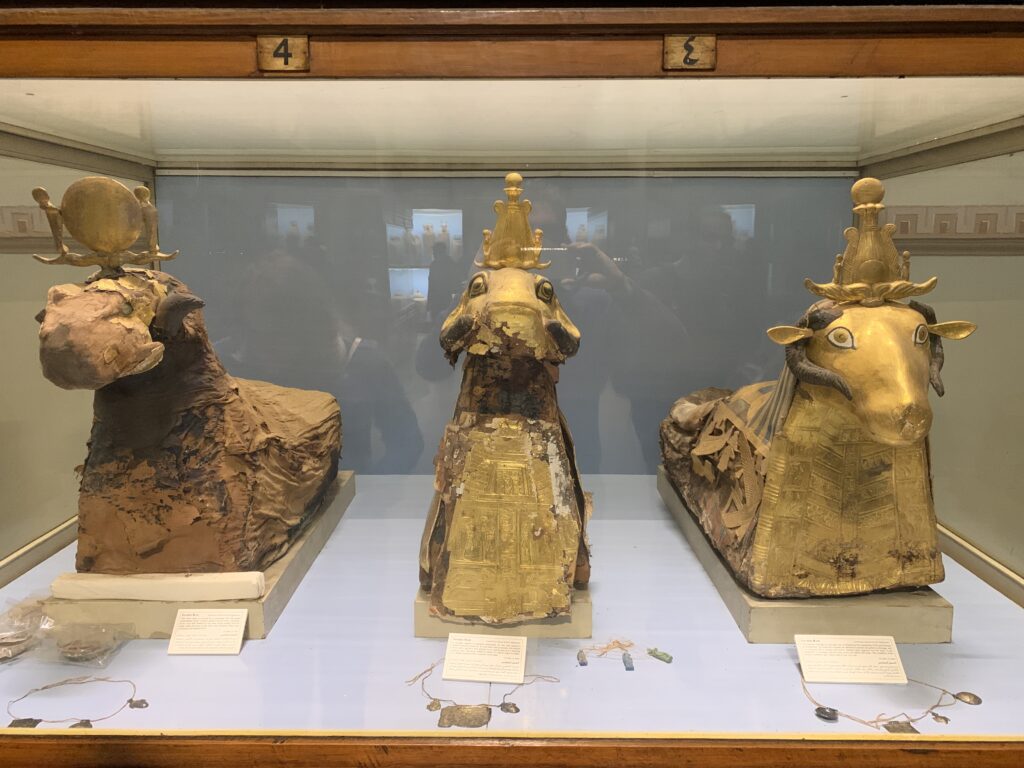
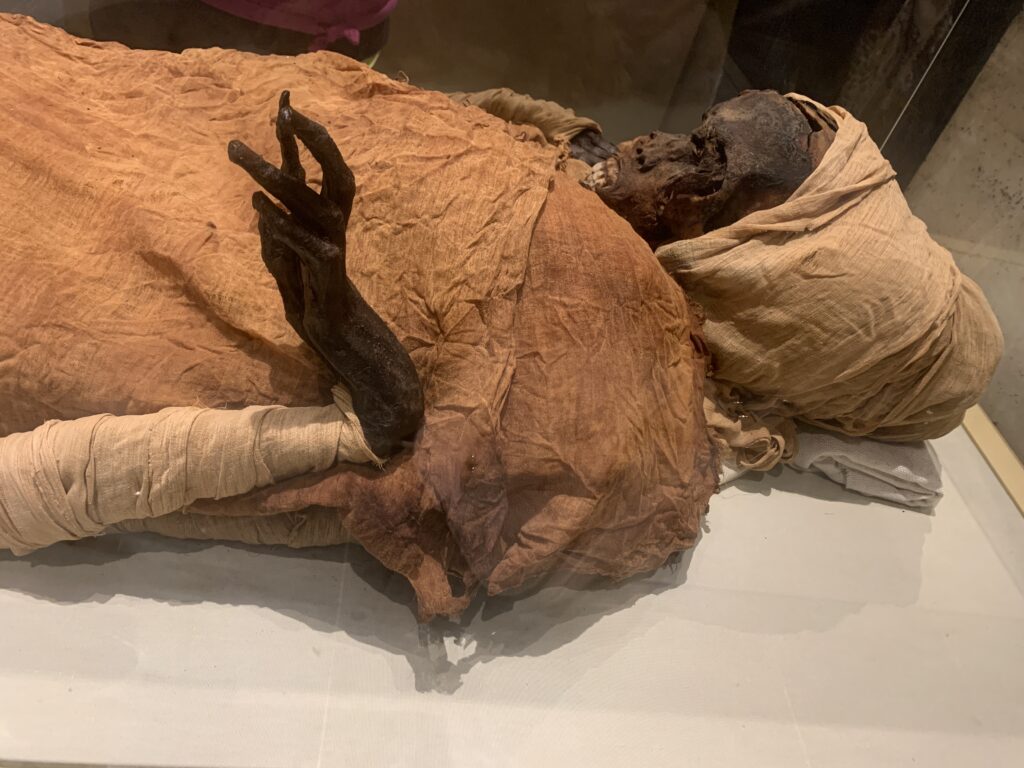
Always on the upper floor, a wing is dedicated to the treasures of the tombs of Yuya and Tuhya, the parents of Nefertiti. Their richness is manifested in the gilded artifacts and in the beauty of their sarcophaguses, with their mummies inside in pristine conditions. In the smaller, adjacent room an exhibition of utensils (from combs to spires, from tweezers to arc, from agricultural tools to mirrors, from dices to carving tools) will allow you to understand how the Egyptians were living their everyday life and conquered so much with so little
Day 3 - Old Cairo and the Citadel
Today we made a jump forward in history. The ancient Egyptian Dynasties ended when Alexander the great conquered Egypt and the greek culture pervaded the country. During the Ptolemaic Kingdom, the Roman Empire expansion to Egypt was made famous by Cleopatra, her liaison with Julius Caesar and later with Marc Anthony that she followed to was against Octavianus Augustus, a war that was lost thus delivering Egypt to the Romans. At the time, the capital of Egypt was still Alexandria, the city founded by Alexander the Great, and the Romans built the first nucleus of Cairo which was a fortress named Babylon (900 ac).
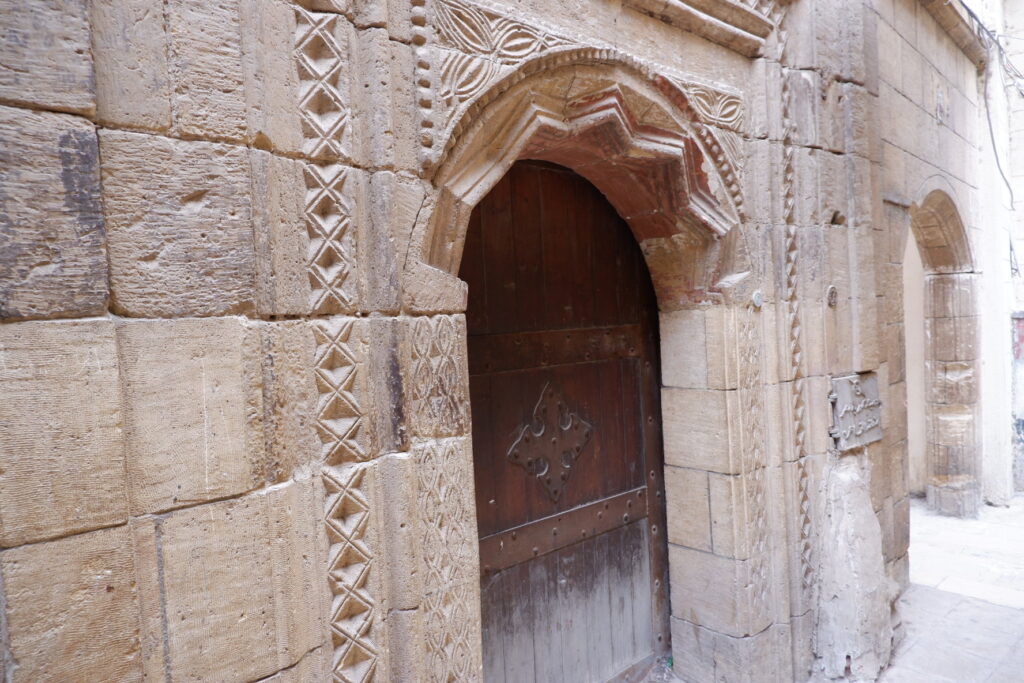
While walking towards the stairs that will take you to the heart of Babylon, notice Cairo Metro line on your right. It was built where once a canal of the Nile river was running, a natural passage to the Red Sea (a sort of primitive Suez Canal) and made the commerce blooming in this area. This was the reason behind the Roman decision to build the fortress on this site as a protection for the traders.
When, under Emperor Constantine, the Christian religion became the official religion of the Roman Empire and the persecution stopped, churches started to sprout in the fortress that today represents old Cairo. Helen, mother of Constantine, ordered the construction of numerous churches in this area. This site was considered particularly holy for the Christians because, according to the Bible, the Holy Family stalked by Herodes intent on killing the newborn king, seek shelter in a cave in this area for three months. On the site of the cave the Christian built the Cave Church, or Church of Saint Sergius. As the majority of the religious places that you will visit today, this church that dates III century has a basilica-style layout with three aisle separated by Corinthian columns. Differently from Catholic churches, coptic churches have icons all around their walls and an “iconostasis”, an ebony wooden wall that separates the transept from the main seating area and through which the worshipper takes the Eucharist. The “coptic” term through which Egyptian Christians are referred with, comes from the greek name Egyptos that the arabs that followed the Romans could not pronounce. Coptic Christians have their own cross with 4 arms, the trinity symbol at the end of each arm the cross of David in the center and symbol of Christian fishes between the arms. Coptic Christians also have their own language, derived from Greek with the addition of seven letters (this was an additional help to Champollion in deciphering hieroglyphics).
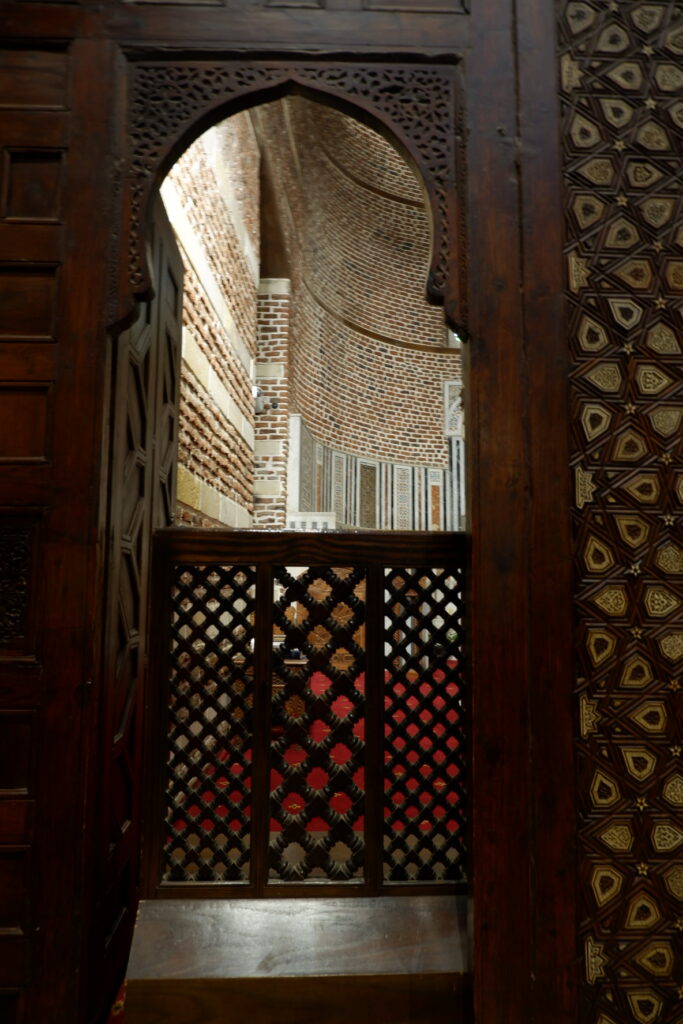
A ramp of stairs will take you to the Church crypt where you can admire the cave where according to tradition the Holy Family hide for 3 months and the well from which they drank. Here the first church was built in the I Century.
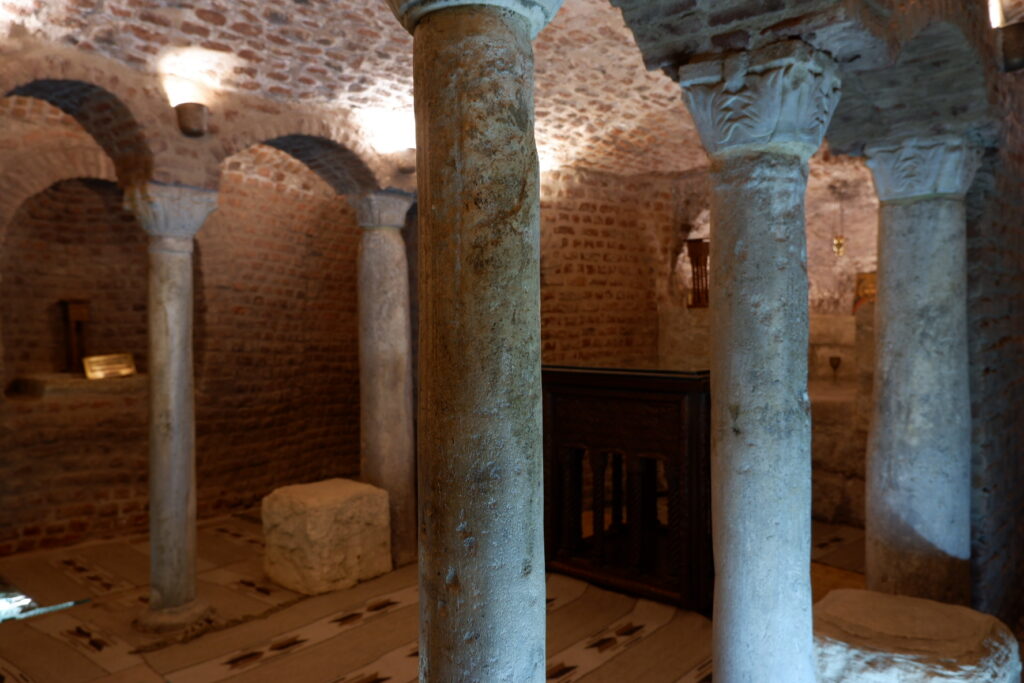
Follow the road outside of the Cave Church and you will reach the Ben Ezra Synagogue, an old church that in the X century was sold to the Jew Ben Ezra to cover some of the Christians debts. Once again, the location is not casual: according to the tradition, the daughter of the pharaoh found the basket with baby Joseph inside just in the nearby canal. Nowadays the Synagogue is not being used due to the paucity of Jews in Egypt: it takes at least 10 man to preach a liturgy and there are less than 200 Jews in all Egypt. that has not always be the case, the population was over 200.000 before Israel was created, but the majority of them moved to the new country and the relationship between Israel and Egypt has never been too good. Egypt never supported the creation of Israel; in 1967 president Nasser was so aggressive against Israel that the Israeli retaliated by invading Sinai and keeping it until 1973, when the Egyptian army declared war to get the region back. A cease-fire from the United Nations brought the two countries to a peace treaty with which Israel gave Sinai back to Egypt as long as the region was kept a demilitarizing zone.
Retrace your steps and walk the stairs up to the convent of Saint George, a greek orthodox church with 25 monks living inside. Next to the convent, the greek cemetery hosts the body of the previous orthodox pope who died in a plane crash. The convent is beautiful from the outside, but the inside was completely rebuilt inside after the fire of 1967; only the marble columns are original.

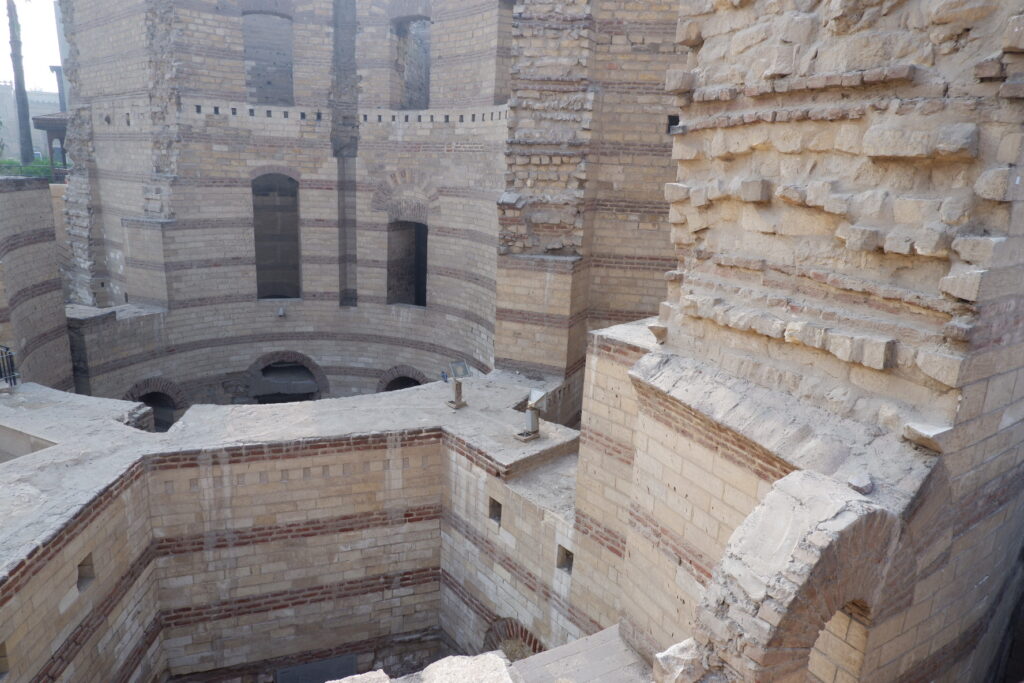
Right after the convent, just by the side of the road on your left, stop to have a look at the remains of one of the turrets of the fortress. This will help you understand how the next church on the itinerary is a true rarity, the Hanging Church. You will immediately notice that the church is located on top of a ramp of stairs, elevated from the level of the street: this is because it has no fundaments, it was built using 2 adjacent turrets as support and bridging them with palm trunks. Once you reach the top of the stairs, the corridor to access the church displays on the right the photos of some of the 118 coptic popes and on the left of the King Farouk (last King of Egypt before the presidential republic in 1952), and the following presidents (Nasser and Mubarak among the most famous).
The church is dedicated to Saint Mark; originally from Tunisia, Saint MarK started following Jesus as an apostle (this is why the Coptic religion is “apostolic” and has its own pope). According to tradition, the Last Supper was held in his house. After the Resurrection, Saint MarK went to Europe and only years later started preaching the Bible in Alexandria and the whole Egypt. Persecuted by the Romans, he was finally beheaded and his head was sent to Rome: only in 1967 it was brought back to Cairo where it is still kept inside the cathedral. Inside the church, some of the numerous icons represent Saint Mark; notice how is skin is dark, despite him coming from a land of fair-skinned people he was often depicted with a darker tan since his worshipper wished he was Egyptian. Next to his icon, in the right corner, you can find a Madonna of the XVIII century referred to as the “Egyptian Monna Lisa” due to her eyes following you.
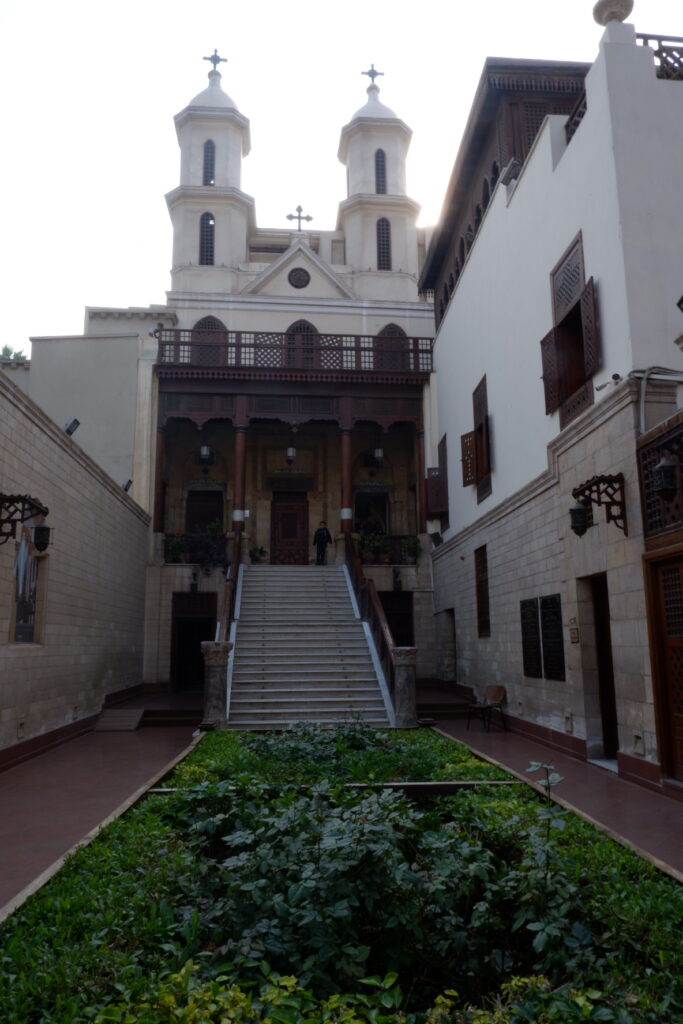
Now raise your heads to the ceiling, it’s entirely made of wood and in the shape of a boat, symbol of salvation. The pulpit is made of 15 columns, one in front symbolizing Jesus, 12 for the apostles and 2 for Saint Mark and Saint Luc (evangelists). If you wish to better understand what lies beneath your feet, go to the room on your right hand side. Here you can appreciate looking through a glass floor the round shape of one of the two towers, the palm trunks and the lack of foundations.
The church is dedicated to Saint MarK; originally from Tunisia, Saint MarK started following Jesus as an apostle (this is why the Coptic religion is “apostolic” and has its own pope). According to tradition, the Last Supper was held in his house. After the Resurrection, Saint MarK went to Europe and only years later started preaching the Bible in Alexandria and the whole Egypt. Persecuted by the Romans, he was finally beheaded and his head was sent to Rome: only in 1967 it was brought back to Cairo where it is still kept inside the cathedral. Inside the church, some of the numerous icons represent Saint Mark; notice how is skin is dark, despite him coming from a land of fair-skinned people he was often depicted with a darker tan since his worshipper wished he was Egyptian. Next to his icon, in the right corner, you can find a Madonna of the XVIII century referred to as the “Egyptian Monna Lisa” due to her eyes following you. Now raise your heads to the ceiling, it’s entirely made of wood and in the shape of a boat, symbol of salvation. The pulpit is made of 15 columns, one in front symbolizing Jesus, 12 for the apostles and 2 for Saint Mark and Saint Luc (evangelists). If you wish to better understand what lies beneath your feet, go to the room on your right hand side. Here you can appreciate looking through a glass floor the round shape of one of the two towers, the palm trunks and the lack of foundations.
The Arabs conquered Egypt in 641 ac, defeating the Romans. They were not used to living by the sea, so they changed the capital from Alexandria to Cairo, and built the first mosque right outside the Roman fortress that forms Old Cairo. Only the posterior section is original, the rest of the mosque has now been reconstructed since it was originally built in mud bricks that did not survive through the centuries. The following Arab dynasties started employing Christian architects that introduced them to the use of bricks.
After getting Jerusalem back from the crusaders, Salah ad-Din conquered Egypt in the XII century and built at the edge of Cairo the Citadel to host his court. A little car ride will take you to this vast fortress on a plateau at the borders of Cairo. From the Citadel the Sultan’s slaves, the Memluk, rebelled in the XIII century and took control of the country keeping the power until the Ottomans defeated them in 1517. We did not visit the Citadel inside, but from the outside you can admire the Alabaster Mosque of Mohamed Ali. Built in the style of the Blue Mosque in Istambul, it was commissioned by Mehmet Ali, an Albanian serving in the Turkish army that in 1805 took the power and founded a royal dynasty that continued up to King Faruk in 1952. Inside the Citadel, Mehmet built a royal palace that was used by his successors up to his nephew that took the court to the royal palace in downtown Cairo.